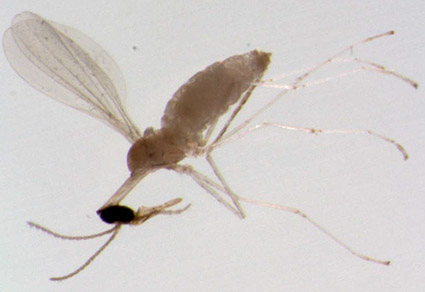Abstract
Camillemyia prominens Gagné, gen. n. et sp. n., (Diptera: Cecidomyiidae; Cecidomyiinae) is described for a gall midge from Mexico with an extremely elongate neck and proboscis. The external and internal basic composition of the proboscis of Cecidomyiidae, as exemplified by Cecidomyia resinicola Osten Sacken, is reviewed to help understand the structural changes found in Cam. prominens as compared to those of Contarinia prolixa Gagné & Byers, another species with spectacularly modified mouthparts.
References
- Cumming, J.M. & Wood, D.M. (2017) 3. Adult Morphology and Terminology. In: Kirk-Spriggs, A.H. & Sinclair, B.J. (Eds.), Manual of Afrotropical Diptera. Vol. 1. Introductory chapters and keys to Diptera families. Suricata 4. South African National Biodiversity Institute, Pretoria, pp. 89‒133.
- Gagné, R.J. (2018) Key to Adults of North American genera of the Subfamily Cecidomyiinae (Diptera: Cecidomyiidae). Zootaxa, 4392 (3), 401–457. https://doi.org/10.11646/zootaxa.4392.3.1 DOI: https://doi.org/10.11646/zootaxa.4392.3.1
- Gagné, R.J. & Byers, G.W. (1985) A remarkable new Neotropical species of Contarinia (Diptera: Cecidomyiidae). Journal of the Kansas Entomological Society, 57, 736–738.
- Gagné, R.J. & Jaschhof, M. (2021) A Catalog of the Cecidomyiidae (Diptera) of the World. 5th Edition. 813 pp. Available from: https://www.ars.usda.gov/ARSUserFiles/80420580/Gagne_Jaschhof_2021_World_Cat_5th_Ed.pdf (accessed 5 April 2023)
- McAlpine, J.F. (1981) Morphology and terminology—Adults. In: McAlpine, J.F, Peterson, B.V., Shewell, G.E., Teskey, H.J., Vockeroth, J.R. & Wood, D.M. (Eds.), Manual of Nearctic Diptera. Vol. 1. Research Branch Agriculture Canada, Monograph No. 27. Canadian Government Printing Center, Quebec, pp. 9‒63.
- Matsuda, R. (1965) Morphology and evolution of the insect head. Memoirs of the American Entomological Institute, 4, 1–6 (unnumbered) + 1‒334.
- Peterson, A. (1916) The head capsule and mouthparts of Diptera. Illinois Biological Monographs, 3, 177‒282, 23 pl. https://doi.org/10.5962/bhl.title.70751 DOI: https://doi.org/10.5962/bhl.title.70751
- Snodgrass, R.E. (1943) The feeding apparatus of biting and disease-carrying flies: a wartime contribution to medical entomology. Smithsonian Miscellaneous Contributions, 104, 1‒51.
- Solinas, M. (1965) Studi sui Ditteri Cecidomyiidi. 1. Contarinia medicaginis. Kieffer. Bollettinodell’ Istituto di Entomologia della Università di Bologna, 27, 249‒300.


